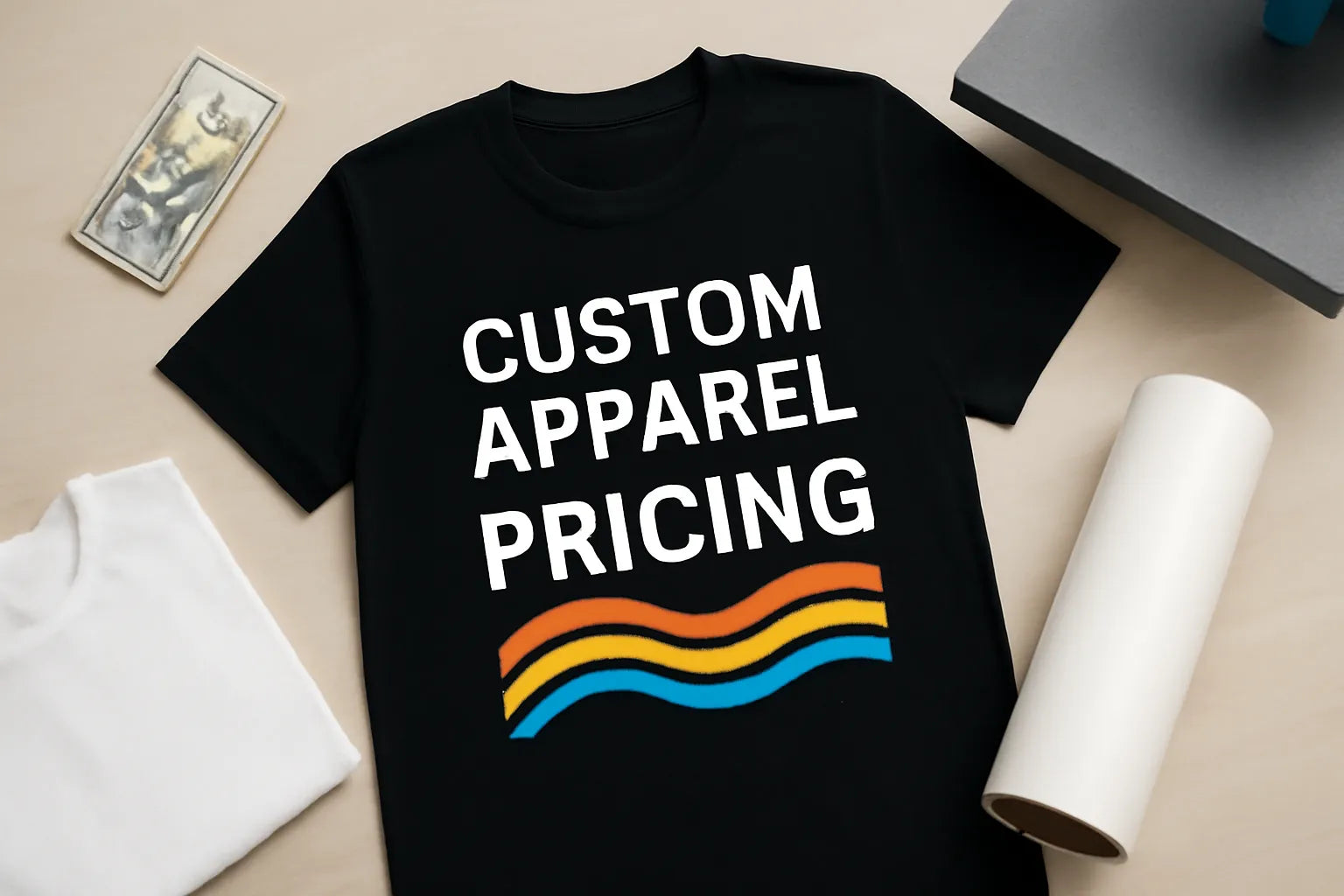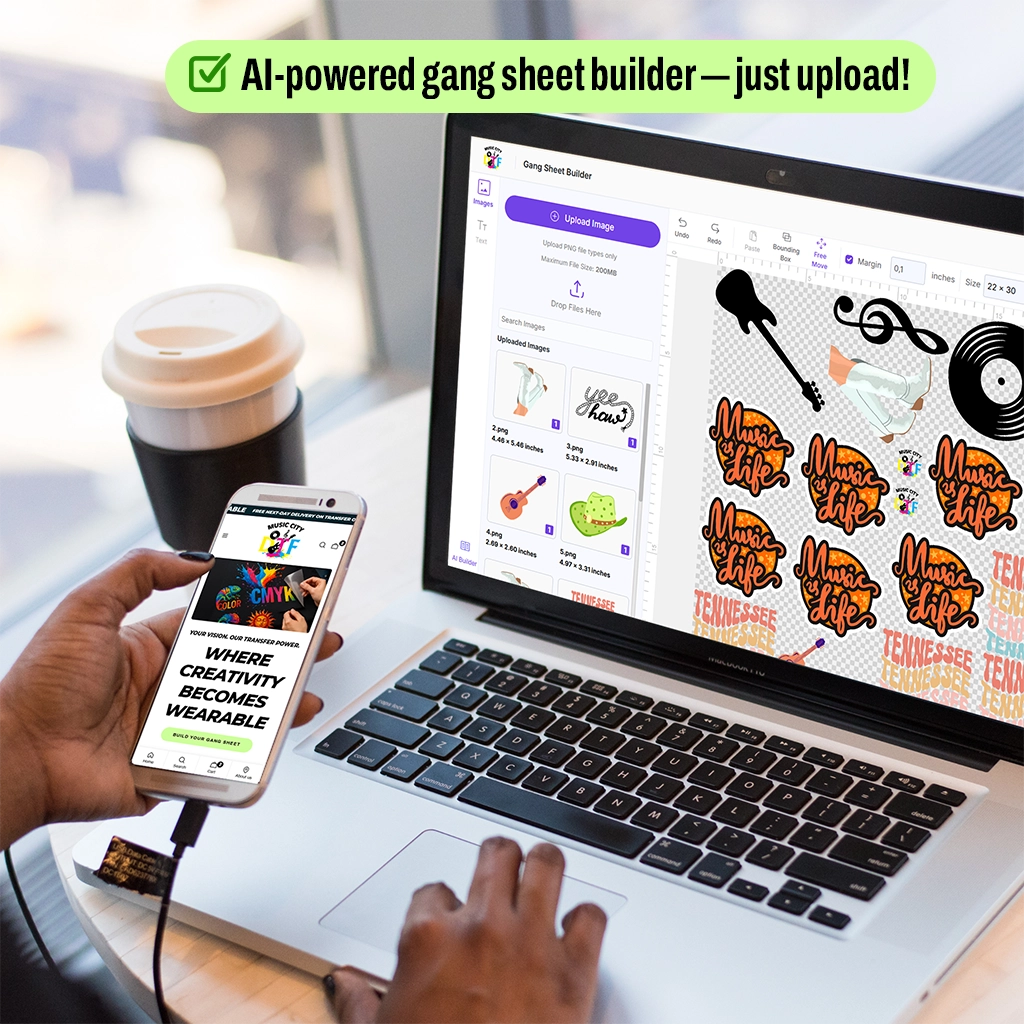Custom apparel pricing is a crucial aspect of DTF shirt printing. Particularly when using Direct-to-Film (DTF) printing, running a custom apparel company can feel like a complex juggling act. Even if you want to stand out with competitive pricing, you must make sure your company is not merely breaking even. Higher margins result from purposeful pricing strategies that consider costs, client perceptions, and the market, rather than random pricing. In this post, we will go through tactics that'll help you learn how to price custom t-shirts, and explore five innovative ways to price DTF transfers so you're building a sustainable and successful company rather than simply selling t-shirts with limited revenue.
1. Custom Apparel Pricing: Go Beyond Ink and Shirts
Setting prices, many businesses concentrate just on the direct cost of blanks and ink; real profitability, though, starts with seeing the whole picture.
Add Hidden Production Costs
Your DTF prints require preparation time; it covers film, adhesive powder, heat press power, and your own design, printing, and pressing hours. Costs accumulate even for small items, such as maintenance on the heat press, cleaning supplies, and software subscriptions. By noting every hidden and frequent cost, including packing and postal labels, you can determine your genuine cost per shirt.
Include this in your dtf printing cost breakdown and use it in your dtf apparel pricing guide.
Include Your Time as True Worth
Money is time. Whether you're creating visuals, compiling gang sheets, or communicating with customers, these hours should be valued. Set your own hourly rate and add it to the production cost to ensure that your profit reflects your work, even when you run a one-man company.
Understanding the actual price of every product will enable you to price your custom DTF transfers and protect your profit, even if the market shifts.
2. Include Perceived Value Rather Than Simply Cost-Based Markups
Many beginners use a basic formula: total cost multiplied by markup. They generally skip experience, design, and creativity. Price your transfers with everything in mind, including the supplies and the talent that goes into making the final product.
Provide Original Patterns
Premium rates may be demanded for limited edition collections, collaborations with local artists, or seasonal releases. Customers see them as premium rather than normal, and thus are willing to pay more. Wisely use scarcity: announce modest runs to create demand and justify higher pricing.
Increase Your Brand Visibility
Better packaging, branded tags, and professional product shots increase perceived value. To the customer, a $25 tee given with premium mocks, narrative, and a single website feels worth $40. Consistent branding and professional graphics make your product a lifestyle item, not just a piece of clothing.
Clients initially purchase emotionally, then justify the purchases later. Enhanced perceived value shields your margins and helps you negotiate more favorable pricing.
3. Tier Your Pricing
Each product does not need to have a specific price range. Innovative companies use tiered pricing to capture several levels of consumer buying power.
Arrange Good, Better, Best Options
Offer, for instance, a basic tee at a reduced price, a mid-tier premium fabric shirt, and a top-tier alternative with personalized packaging or embroidered additions. Typically, the top-tier product has the largest margin; the entry-level product helps keep your brand accessible.
Use Extras and Upsells With Careful Consideration
Personalization offers opportunities, such as including a name or number, coordinating caps, or package savings on multiple products. These tiny add-ons only provide you with a significant profit per order. Offering gift wrapping or expedited delivery at checkout can increase revenue without incurring additional manufacturing costs.
Tiered pricing allows you to profit more from customers willing to pay, while keeping your store affordable for budget-conscious shoppers. This is an excellent pricing strategy for apparel brands looking to increase custom clothing profit margins.
4. Know Your Competitors and Your Market
You cannot price accurately in isolation. Research your rivals to grasp the range of possibilities, not to imitate, but to excel. Check the pricing tiers offered by your competitors and adjust your pricing accordingly to provide customers with a better, more affordable option.
Explore Comparable Companies and Markets
Consider dtf printing business brands targeting a comparable style or audience. Pay attention to their pricing, shipping expenses, and product description. Determine where your offer belongs: Do you offer faster turnaround, better custom-made designs, or higher quality? This helps to support your price range.
Understand the Spending Patterns and Budget of Your Perfect Client
Are you targeting high school sports teams, small business merchandise, or streetwear enthusiasts? Different markets accept different price ranges. While small business owners may value affordability over exclusivity, streetwear consumers are willing to spend $ 60 or more for a distinctive design.
Matching your price to what your perfect client is ready to pay (and expects) means you won’t leave money on the table.
5. Include Margin in Your Strategy, Not Just the Price Tag
Profitability is determined by how you design your whole company around preserving your margin, not just the sticker price.
Batch Production to Reduce Unit Costs
Rely on DTF business profit tips, such as using gang sheets and batch printing to create several patterns simultaneously. Spreading film and press charges across more shirts helps to reduce the per-shirt expense. This lets your prices stay competitive without lowering your profit.
Price Your Custom DTF Transfers Depending on Demand
Raise the price slightly or create a "premium" version. High-demand goods have greater margins because scarcity increases value. Also, use limited-time offers to sell products that sell slowly without permanently lowering pricing.
Why Choose Music City DTF for Premium DTF Transfers
Choose Music City DTF for DTF transfers that sell well. We utilize high-quality materials, vibrant colors, and a skilled workforce to create transfers that look amazing on clothing. You get fast service, reliable prints, and custom help, so your designs look great and get your brand noticed. Enhance the appeal of your apparel with transfers that people will love and purchase.
Final Thoughts
Pricing your custom dtf apparel for greater margins is about knowing what your product is truly worth, what your client values, and what sets your company apart, not just numbers. Start with real expenses, then use design and presentation to increase value. Offer multiple price points to cater to a range of consumers. Understand your market and employ dynamic methods to safeguard revenue as your brand expands.
If you provide actual value, a slightly higher price won't turn off clients. A price that is too low, however, can keep your company locked in a cycle of hard labor devoid of reward. You will create a brand that is not only beloved by consumers but also highly profitable by thinking strategically (not emotionally) about price.
Ready to take your revenue further? Check our DTF Sample Pack to see and experience the quality before you establish your prices. Purchase your sample pack now and price your personalized clothes with confidence!





